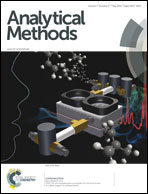Preparation and characterization of tripeptide chiral stationary phases with varying amino acid sequences and terminal groups†
Abstract
In this study, two tripeptide bonded chiral stationary phases (CSPs) on silica have been prepared and evaluated in order to investigate the effect of amino acid sequence and 5-nitronicotinoyl as the terminal group on chiral separation in HPLC and to study the chiral recognition mechanism. Phenylalanine, proline, and valine were selected as the chiral moiety of CSPs, and the resultant two CSPs (CSP 1 and CSP 2) provide effective recognition and separation of adrenoceptor agonists and analytes containing amide or naphthalene rings with different selectivity profiles. CSP 1 typically affords higher enantioselectivity for those analytes facilitating stronger π–π interaction, whereas CSP 2 is more pronounced for separation of enantiomers bearing more hydrophobic groups. This work has demonstrated the importance of amino acid sequences which strongly impacted the chiral separation selectivities of these two CSPs. 5-Nitronicotinoyl as an analogue of 3,5-dinitrobenzoyl (DNB) exhibited similar enantioseparation ability and could form π–π interaction with analytes by combining with phenylalanine.


 Please wait while we load your content...
Please wait while we load your content...